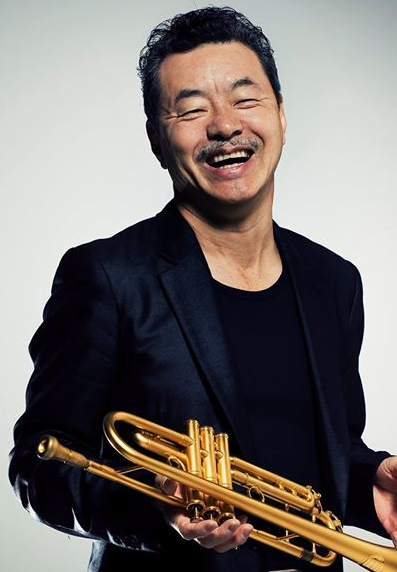Long considered a jazz legend and Japan’s foremost trumpeter, Terumasa Hino has played with almost all the jazz heavyweights throughout the past half century, from Gil Evans and Elvin Jones to Herbie Hancock and Chick Corea. Born in Tokyo in 1942, Hino made his professional debut at the tender age of thirteen, drawing his main inspiration from Freddie Hubbard and Miles Davis. For the first few years of his career, Hino was something of an opportunist, even jumping open Japan’s early ‘60s eleki bandwagon with the cash-in LP TRUMPET IN BLUEJEANS. However, his fiery temperament and ‘large brilliant tone’, as The Grove Dictionary of Jazz termed it saw Hino’s late ‘60s work increase both in output and quality, and his 1969 Columbia LP HI-NOLOGY was extremely successful commercially. Hino celebrated the new decade with the LP JOURNEY TO AIR, a hugely inventive disc taken up by the single title track, itself split into two sections ‘Part 1 – Gongen’; and ‘Part 2 – Peace & Love’. JOURNEY TO AIR also introduced future Miles Davis sax player Dave Liebman, while the LP’s European success enabled Hino to play at the Berliner Jazztage in 1971. Thereafter, he released the LPs VIBRATIONS and LOVE NATURE in rapid succession, whilst working concurrently as an editor of Miles Davis transcriptions. In June 1973, The Terumasa Hino Quintet released two amazing live LPs recorded on different continents. The LP LIVE! was recorded in Tokyo on June 2nd and released on the hip Three Blind Mice label, whilst TARO’S MOOD was captured in Munich, at The Domicile Jazzclub, and released on Germany’s Enja label. Both records were hugely raw and intoxicating by virtue of their long drawn out tracks, extreme percussive overload – supplied on both occasions by drummer Motohiko Hino and master percussionist Yuji Imamura – and Hino’s ability to stretch out from straight ahead melody to charging elephant cacophony. Indeed, the 25-minutes of ‘Predawn’ (which takes up all of side two of TARO’S MOOD) and the 28-and-a-half minutes of ‘Be And Know’ (which takes up the whole of side two of LIVE!) are two of my all time favourite pieces of Japanese music. Hino thereafter dropped the quintet, returning to the recoprding studio, in January 1975, for the epic sound of SPEAK TO LONELINESS. Again opting for one side long track and two slightly shorter affairs, the LP introduced a bigger, more brass orientated sound. Later in ’75, Hino moved to New York, where he worked with arranger Gil Evans Elvin Jones and Dave Liebman. His 1977 LP MAY DANCE was released on the Japanese Flying Disk label, and featured ex-Miles Davis stars Ron Carter on bass and Tony Williams on drums, plus legendary guitarist John Scofield. The music became a little typical of his New York environment until 1981’s Columbia LP DOUBLE RAINBOW, which appeared to be a a very successful homage to Miles’ lost 1975 funkathon period. Indeed, the fifteen minute opener, Masabumi Kikuchi’s ‘Merry-Go-Round’ opts for an AGARTHA-type atonal funk vibe, Kikuchi’s own organ intro highly reminiscent of Miles’ claw-handed voodoo take on Sly Stone’s sould keyboards. Moreover, Kiyoshi Itoh’s mixing style also apes many of the mix ideas that Teo Macero introduced to Miles Davis LPs. Thereafter, Hino returned to Japan to live and work throughout the ‘80s, which is outside the scope of this book. Julian Cope from http://www.japrocksampler.com Born 25 October 1942, Tokyo, Japan. Following, more or less literally, in the footsteps of his trumpet-playing, tap-dancing father, Hino learned to tap at the age of four, and took up the trumpet when he was nine years old. He taught himself the principles of jazz improvisation by transcribing solos by Miles Davis (from whom, no doubt, he learned his conviction about the importance of space), Louis Armstrong, John Coltrane, Clifford Brown, Lee Morgan and Freddie Hubbard. He began playing publicly in American army clubs in 1955 in Japan, then joined Hiroshi Watanabe and Takao Kusagaya, but his first major job was with the Hideo Shiraki Quintet, where he stayed from 1965-69. During 1964/5 he had led his own group, and left Shiraki at the end of the decade in order to lead his own band full-time. In 1974 he worked with Masabumi Kikuchi, then in June 1975 he went to the USA and worked with Joachim Kuhn (1975), Gil Evans, Jackie McLean and Ken McIntyre (1976), Hal Galper (1977), Carlos Garnett (1977), Sam Jones (1978), Elvin Jones (1982) and Dave Liebman, as well as continuing to lead his own group, the band which John Scofield credits as moving him from fusion to jazz. By then Hino was dividing his time equally between the USA and Japan. He plays trumpet and flgelhorn with a mellow fire, and his fame in Europe continues to grow almost matching his reputation in Japan and the USA. He toured Europe with Eddie Harris in November 1990, and was reunited with Kikuchi for a rhythmic 1996 recording session featuring alto saxophonist Greg Osby. from http://www.music.us
